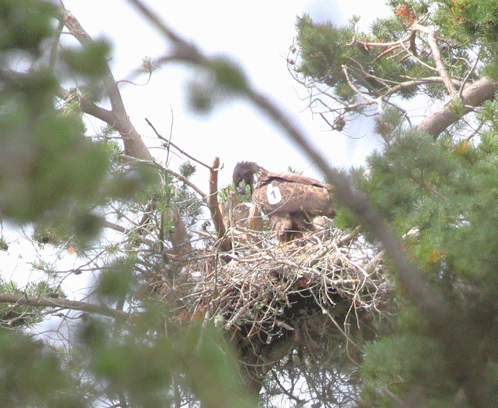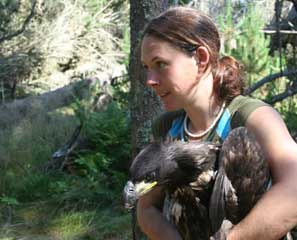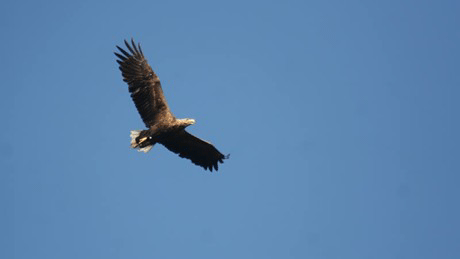EAGLE REINTRODUCTION PROJECT CELEBRATES FLIGHT OF FIRST WILD CHICK
EAGLE REINTRODUCTION PROJECT CELEBRATES FLIGHT OF FIRST WILD CHICK
For the first time in almost two centuries white-tailed sea eagles have bred in the east of mainland Scotland.
Conservationists have confirmed that a pair, released in 2009 as part of a successful reintroduction project, have raised one chick in a Forestry Commission Scotland wood in Fife.
Between 2007-2012, RSPB Scotland, Scottish Natural Heritage and Forestry Commission Scotland, with additional financial support from Heritage Lottery Fund (HLF) and Fife and Rural Tayside LEADER Programme 2007-2013, reintroduced a total of 85 eagles to Scotland’s east coast. Their progress and whereabouts continue to be regularly monitored by project staff and volunteers.

Having found a safe and secure home, the adult pair successfully reared a healthy male chick which was fitted with a leg ring and white wing tags with black numbering, earlier this summer by trained and licensed ringing experts.
Minister for Environment and Climate Change Paul Wheelhouse said: “This is fantastic news – it is the first chick in almost two hundred years to be hatched on the mainland of the east coast, which was the ultimate aim of the reintroduction project. I hope it will be the first of many of this magnificent species which will eventually spread their territories right across Scotland. I’d like to thank all partners who have played their part in making this exciting and special event happen.”

Stuart Housden, Director of RSPB Scotland, said: “This chick marks a huge milestone in our partnership to restore white-tailed eagles to their former range in the south and east of the Country. This success further strengthens the strong bond we have formed with the people of Norway, who kindly gifted birds for release in Scotland throughout the reintroduction process, which started over 30 years ago on the West coast. Young birds successfully released 5-6 years ago are now pairing up in the wild-and we are very excited a chick from a nest in Fife has safely fledged. We owe a great deal to the project staff, farmers, landowners, partners and of course the general public for their support and enthusiasm. Our focus now will be to continue monitoring this youngster and the other east coast birds with the expectation of more breeding attempts next year. These wonderful birds are back! As always project officer Rhian Evans is keen for any east Scotland eagle sightings to be reported to her at eastscotlandseaeagles@rspb.org.uk”
Ron Macdonald, SNH’s Head of Policy & Advice, said: “After almost 200 years, it’s wonderful to have a sea eagle chick fledge again in the east of Scotland. With the west coast eagles already established, this is a good step towards a healthy population of sea eagles across the country.”
Colin McLean, Head of the Heritage Lottery Fund, Scotland, said: “The arrival of this chick marks the beginning of a new era for the sea eagles in the east coast of Scotland. The Heritage Lottery Fund is delighted to be involved in reversing the fate of these rare, once native, birds. They are part of Scotland’s natural heritage and it is the prospect of glimpsing rare species, such as the glorious sea eagle, that attracts visitors to our shores bringing much-needed tourist income to our communities.”

Once a regular sight in Scotland’s skies, the white-tailed eagle was driven to extinction in the Victorian era. The last native white-tailed eagle was killed on Shetland in 1918. The species only returned to the UK following a successful reintroduction to the West of Scotland, starting on the Island of Rum in 1975.
As well as helping return the UK’s largest birds of prey, the project has also strengthened links between Scotland and Norway, where the sea eagle population is strong. Project staff worked closely with Norwegian colleagues visiting nesting sites and selecting suitable chicks to use for the East Scotland reintroduction.
Although the majority of the Scottish population remains on the west of the country, the species is now regularly spotted in Eastern and Central Scotland too.
